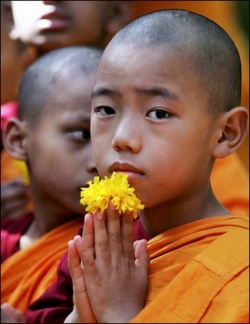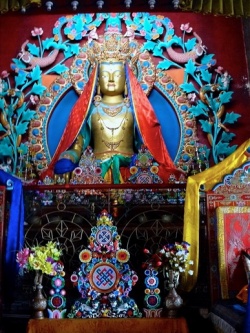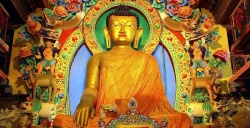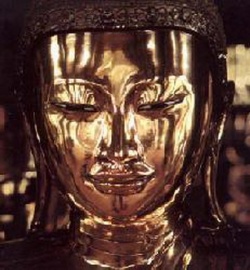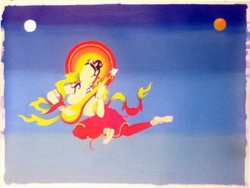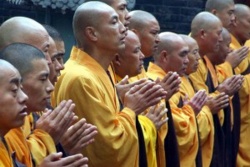Citta
- For other uses of word citta see Citta(Names)
Citta (Pali) is one of three overlapping terms used in the nikayas to refer to the mind, the others being manas and viññāṇa. Each is sometimes used in the generic and non-technical sense of "mind" in general, and the three are sometimes used in sequence to refer to one's mental processes as a whole. Their primary uses are, however, distinct.
The Pali-English Dictionary suggests citta is heart / mind, and emphasizing it is more the emotive side of mind as opposed to manas as the intellect or mind-sense in the sense of what grasps mental objects (dhammas ). Citta is the object of meditation in the third part of Satipatthana, also called four foundation of mindfulness.
"Citta" primarily represents one's mindset, or state of mind. Citta is the term used in to refer to the quality of mental processes as a whole. Citta is neither an entity nor a process; this likely accounts for its not being classified as a skandha, nor mentioned in the paticcasamuppada formula.
The complex causal nexus of volition's (or intentions) which one experiences continuously conditions one's thoughts, speech, and actions. One's state of mind at any given time reflects that complex; thus, the causal origin of actions, speech, and thoughts is sometimes associated with the state of mind (citta), in a manner of speaking. This does not mean that it is that causal nexus; it is better understood as an abstract reflection. One's mind-set can be out of tune with one's desires or aspirations. In that it reflects the volition's, the citta is said to go off with a will of its own if not properly controlled. It may lead a person astray or, if properly controlled, directed, and integrated, ennoble one.
One may "make citta turn according to" his wishes most effectively by developing skill in meditative concentration which brings mental calm and clarity. An individual undergoes many different states of mind; M.II.27 asks: "Which citta for citta is manifold, various, and diverse." Generally speaking, a person will operate with a collection of changing mindsets, and some will occur regularly. While these mindsets determine the personality, they are not in control of themselves, but fluctuate and alternate. There is thus the need for the meditative integration of personality to provide a greater, more wholesome consistency.
Regarding volition's, there is a similarity between viññāna and citta; they are both associated with the qualitative condition of a human being. Viññāna provides awareness and continuity by which one knows one's moral condition, and citta is an abstraction representing that condition. Citta is therefore closely related to volition's; this connection is also etymological, as citta comes from the same verbal root in Pali as the active terms meaning "to will." Citta also reflects one's cognitive condition/progress.
Citta as a mindset can become "contracted" (i.e., unworkable), "distracted", "grown great", "composed", or the opposite of such qualities (M.I.59). It can be dominated by a certain emotion, so as to be "terrified", "astonished", or "tranquil." It can be "taken hold of" by pleasant or unpleasant impressions (M.I.423). A host of negative emotionally charged states can pertain to it, or it may be free of such states, so it is vital to develop or purify it: "For a long time this citta has been defiled by attachment, hatred, and delusion. By defilement of citta, beings are defiled; by purity of citta, beings are purified" (S.III.152).
Attaining a purified citta corresponds to the attaining of liberating insight. This indicates that a liberated one's state of mind reflects no ignorance or defilements. As these represent bondage, their absence is described in terms of freedom.
Citta was a wealthy merchant who owned a small hamlet named Migapathaka and a forest named Ambarukkhavana. He presented the Ambarukkhavana to the Buddha and His disciples and built a monastery for the Noble One to use as a residence. Citta was one of the Buddha’s model lay disciples. Just as the Buddha encouraged His monks to emulate Sariputta and Moggallana, He encouraged young men to emulate Citta, by saying, "Should a devoted mother wish to encourage her beloved only son in a proper way, she may tell him to emulate the householders Citta and Hatthaka. They are the guiding students for my lay disciples."
When deciding on the Noble One foremost in expounding the Dhamma, the Buddha appointed the Bhikkhu Punna Mantaniputta (who helped ananda attain Sotapanna) and the nun Dhammadinna. Likewise, among the laity, the householder Citta was appointed by the Buddha as the lay disciple foremost in expounding the Dhamma.
This was not Citta’s first encounter with the Buddha. The Jataka stories relate that they were closely associated in a former birth. Citta was the Bodhisatta’s servant in a past birth and followed his master into renunciation (Jataka 488). He was a disciple of Maha Kacchana and had learned analytical and organizational skills, which helped him to expound the Dhamma in a manner that people could very easily understand.
Citta paid great respect and reverence to a certain Bhikkhu named Sudhamma who had entered the Noble Order after hearing the Dhamma from Citta. One day Sariputta, Moggallana, Anuruddha, ananda and several other great disciples arrived at Macchikasanda, the city in which Citta lived. Citta approached them and listened to the Dhamma. Sariputta dispensed a profound discourse, which resulted in Citta’s attaining the second stage of sainthood, Sakadagami. Citta immediately invited the distinguished elders for the following day’s meals. Afterwards he realized that he had left out Sudhamma, to whom he had previously extended his hospitality consistently. Approaching Sudhamma, he let him know of the invitation.
When Sudhamma found out about Citta’s invitation to others he was suffused with jealousy and reprimanded Citta for not having informed him earlier. Even though Citta had since invited him, Sudhamma scornfully declined. However, he could not refuse Citta’s invitation. He joined the others as if nothing had happened and praised Citta’s hospitality. But then he showed his true jealousy by adding scornfully that the meal would have been complete if Citta had offered cream cakes. Citta replied that his favourite monk’s behaviour reminded him of a story of a hybrid of a cock and a crow. The story illustrated the fact that jealousy and the refusal of the invitation were inappropriate behaviours for a monk. And criticizing the food showed poor manners towards a householder. Sudhamma was insulted by this comparison and left abruptly. Citta asked him to visit the Buddha and explain what had happened.
Sudhamma went to the Buddha and complained to Him about the unfavourable comparison made by Citta. The Buddha, however, admonished Sudhamma by saying that his behaviour was inappropriate for a Bhikkhu. Not only was it inappropriate for him to have refused Citta’s invitation through jealousy, but it was also inappropriate that he should have insulted his generous host by complaining about the food served. The Buddha asked, "How could you insult a faithful lay disciple like Citta?" At a meeting of the Sangha where the Bhikkhus’ transgressions were discussed it was decided that Sudhamma should ask Citta’s forgiveness for his behaviour.
Sudhamma then set out to beg forgiveness but on reaching Citta’s house turned back in embarrassment. When the Buddha heard that Sudhamma did not apologize to Citta He had another monk accompany Sudhamma to give him the confidence required to own up to his inappropriate behaviour.
From this incident we see a very significant aspect of the Buddha’s teaching. The Buddha always encouraged persons who had done wrong deeds to ask for forgiveness. But forgiveness was asked from those whom one had wronged. The Buddha realized that people make mistakes and even Bhikkhus from time to time behave badly. He did not grant forgiveness for such deeds. Forgiveness for such deeds could only be granted by the person who had been wronged. The wrongdoer reduces the negative effect of his wrong act by genuine regret. But forgiveness can only be received from the wronged. Whilst one may feel better about the misdeed when admitting wrongdoing to a friend or colleague, they cannot reduce or mitigate the wrong. That can be done only through true regret to the wronged. The wronged should then graciously accept the apology and grant forgiveness.
Forgiveness from the Buddha, Dhamma and Sangha that Buddhists ask for in their daily reciting is a forgiveness for wrongs done to the Buddha, Dhamma and Sangha. Buddhists observe the precepts (modes of conduct) daily but often break the vows they have taken. As these vows are taken of their own free will Buddhists ask for forgiveness from the Buddha, Dhamma and Sangha when they break the precepts. Forgiveness that Buddhists request is for transgressions of the precepts they take daily and for other wrongful deeds they may have committed against the Buddha, Dhamma and Sangha. Buddhist do not ask the Buddha, Dhamma and Sangha for forgiveness for wrongful deeds they may have done to another person. Forgiveness for these should be obtained from the person to whom the wrongful deed was done.
The first documented teaching by Citta relates an event where some senior Bhikkhus were sitting together in the entrance of the monastery discussing whether fetters and sense objects are one and the same. Some of the monks felt that they were the same, while some felt that they were not. Citta joined the gathering and the monks asked him his opinion. He declared that in his view fetters and sense objects were different not only in name but also in meaning.
Citta then used an example to illustrate his viewpoint. He said that just as a pair of black and white oxen tied to a cart were not fetters to each other but were both fettered by a single rope or yoke strap, the sense faculties do not bind the external objects. Instead, they are bound or yoked by craving. The Bhikkhus praised Citta’s understanding of the Dhamma and said that he must surely possess the eye of wisdom.
On another occasion a Bhikkhu named Kamabhu recited a stanza dispensed by the Buddha and asked Citta for its meaning. The stanza with which he needed help was as follows:
"The faultless chariot with its one axle,
And white canopy rolls.
See him coming without blemish,
Without ties, the one who has crossed the stream."
After some reflection Citta explained that the Buddha was referring to an Arahanth, who, without blemish or ties, has crossed the stream. He has done away with greed, hatred and delusion and is safe from the ocean of craving. The chariot is the body, the one axle is mindfulness, the smooth, frictionless holding together of the parts (faultless) is virtue and the white canopy is the final deliverance of emancipation. Impressed by his explanation, the Bhikkhu Kamabhu thanked Citta and praised him by saying that he had surely achieved great wisdom to be able to explain such complex teachings.
One day after some Bhikkhus had partaken of alms at Citta’s house, he accompanied them back to the monastery. It was an extremely hot and dusty day and the monks were perspiring freely. The youngest Bhikkhu, Mahaka, remarked that it was very hot and that wind and rain would certainly be welcome. In this instance Mahaka was not just making an observation. He, who had supernormal powers, was asking permission to use these powers to activate rain. When permission was granted and Mahaka did procure rain to refresh his companions, Citta was very impressed.
Citta then approached Mahaka and asked him to demonstrate more of his supernormal powers. The Buddha had specifically forbidden monks to show off their supernormal powers to the householders for purposes of impressing them or creating awe. Mahaka, however, was very young. Enjoying the praise and attention he was receiving, he placed his coat on a bale of hay and went inside his meditation cell. Then, closing the door, he created a tremendously powerful beam that penetrated through the keyhole and burnt the hay while it left the coat untouched.
Impressed by the powers of one so young, Citta offered to support Mahaka for life. Mahaka, however, realized that he had disobeyed the instruction of the Buddha by showing off his powers. Refusing Citta’s generosity, he left the city in search of a place where he would not be known.
Citta used his knowledge to help both believers and non-believers. A naked ascetic by the name of Kassapa, who was a family friend, decided to visit Citta when he visited Migapathaka. Citta questioned him as to how long he had practised this form of asceticism. His friend replied that he had been an ascetic for thirty years. Citta then asked Kassapa if he had attained any superhuman states of bliss or supernormal insight. Kassapa replied that he had not, that all he had done was to go about naked, shaving his head and dusting his seat.
Kassapa then questioned Citta on how long he had been a follower of the Buddha. When Citta replied that he had been a lay disciple for thirty years, Kassapa asked him if he had attained any superhuman states. Citta replied that he had most certainly attained the four Jhanas of mental ecstasy and that if Kassapa questioned the Blessed One He would confirm that no fetters bound him to the sense spheres. Kassapa immediately realized that Citta was Anagami or non-returner, for it was only those who had attained the stage of Anagami who were assured of birth in a non-sense sphere Brahma world. Kassapa was also surprised that his friend, who was a householder, had attained such a high stage of spiritual development when he himself, worn out through the practice of extreme austerities, had gained none.
Reflecting on his friend’s achievements, Kassapa asked Citta to help him take the robes under the Blessed One. He was duly ordained and before long attained Arahanthship. Other friends of Citta’s such as Sudhamma, Godatta, and Isidatta also became Bhikkhus after discussing the Dhamma with him. They all attained the supreme bliss of Arahanthship and surpassed Citta who reached only the third stage of sainthood. The text does not specify as to why Citta had not considered joining the Noble Order when he had encouraged many of his friends to do so. It is assumed that it is because of his personal life and some obligations he had that necessitated that he remain as a householder.
The laymen, Bhikkhus and Devas respected Citta as a great teacher. When he fell ill just prior to his death, the Devas appeared to him and urged him to aspire to be a world monarch in his next life. Citta then informed them that he was seeking something nobler and higher than to be a world monarch in his next life. He was aspiring for the unconditioned Nibbana. The Devas were obviously not aware that Citta had reached the third stage of sainthood. Those who attain Anagami are reborn in the Suddhavassa Brahma Realm where they eventually attain Arahanthship.
Citta’s relatives, unable to view the Devas, thought that he was delirious as it seemed as if he was talking to himself. He reassured them by affirming that he was talking to invisible divine beings. Then, at the request of the Devas, he gave his last advice to those gathered. Citta requested them to have trust and confidence in the Buddha and the Dhamma and to remain unswervingly generous to the Sangha.
1. Citta is the only thing which is said to obtain the state of “non-clinging” (anupada) “This is immortality, that being the liberated mind (citta) which does not cling (anupada) after anything” [MN 2.265].
2. Citta is the only thing which is said to obtain the state of being “taintless” (anasava) [DN 2.35, MN 1.501, MN 3.20, SN 3.45...etc etc].
3. Citta is the only thing which is said to obtain/is gathered in “the realm of immortality”: “he gathers his mind within the realm of Immortality (amataya dhatuya). This is tranquility; this is that which is most excellent!” [MN 1.436]. “This is immortality, that being the liberated citta” [MN 2.265]. [AN 1.282] “He gathers the mind inside the immortal realm”.
4. Citta is the only thing which is said to be the basis (arammana) for Parinibbana.
Said immediately after Gotama’s physical death: [DN 2.157] “No longer with (subsists by) in-breath nor out-breath, so is him (Gotama) who is steadfast in mind (citta), inherently quelled from all desires the mighty sage has passed beyond. With mind (citta) limitless (Brahma) he no longer bears sensations; illumined and unbound (Nibbana), his mind (citta) is definitely (ahu) liberated.” The taintless (anasava) mind (citta) being = parinirvana: [SN 3.45] “The mind (citta) being so liberated and arisen from defilements, one is fixed in the Soul as liberation, one is quelled in fixation upon the Soul. Quelled in the Soul one is unshakable. So being unshakable, the very Soul is thoroughly unbound Parinirvana).” “This said: ‘the liberated mind (citta) which does not cling’ means Nibbana” [MN2-Att. 4.68].
5. Citta is the only thing which is differentiated from the five aggregates (rupa/vedana/sanna/sankhara/vinnana): “Whatever form, feelings, perceptions, experiences, or consciousness there is (the five aggregates), these he sees to be without permanence, as suffering, as ill, as a plague, a boil, a sting, a pain, an affliction, as foreign, as otherness, as empty (suññato), as Selfless (anattato). So he turns his mind (citta, Non-aggregate) away from these; therein he gathers his mind within the realm of Immortality (amataya dhatuya). This is tranquility; this is that which is most excellent!” [MN 1.436, AN 4.422].
[MN 1.511] “For a long time I have been cheated, tricked and hoodwinked by my citta. For when grasping, I have been grasping onto form, for when grasping, I have been grasping onto feelings, , for when grasping, I have been grasping onto perceptions, for when grasping, I have been grasping onto experiences, for when grasping, I have been grasping onto consciousness.”
6. Citta is the only thing which, when perfected by samadhi and panna, is = Soul (attan): "Steadfast-in-the-Soul (thitattoti) means one is supremely-fixed within the mind (citta)” [Silakkhandhavagga-Att. 1.168]. “'The purification of one’s own mind', this means the light (joti) within one’s mind (citta) is the very Soul (attano)” [DN2-Att. 2.479]. [Silakkhandhavagga-Att. 1.168] "Steadfast-in-the-Soul (thitattoti) means one is supremely-fixed within the mind (suppatitthitacitto)”. [AN 2.6] "Him who is Lord of the mind (citta) possessed with supernormal faculties and quelled, that One is called 'fixed-in-the-Soul' (thitattoti)”. [AN 1.196] "With mind (citta) emancipated from ignorance…this designates the Soul has become Brahma”. [MN 1.213] "The collected and quelled mind is the Supreme Soul”. "Steadfast-in-the-Soul (thitattoti) means steadfast in ones True-nature (thitasabha'vo)" [Tikanipa’ta-Att. 3.4].
7. Citta is the only thing which is said to be the basis/medium for the recollection of past lives: “directs his mind (citta) to the recollection of past lives” [DN 1.81].
8. Citta is the only thing which is said to be “its own foundation/not based in anything” (anarammana), therein philosophically anything which is “a thing in itself”, i.e. “without a foundation of its own” is hence the basis for marking the mind as the Absolute (when wisdom and samadhi are culminated): Pati-A 2.478 “The sovereign-mind which is its own support (an-without + a’rammana=support) means the sovereign-mind is the foundation”. Dh-A 4.26 “Ones own mind is the foundation of the Soul”. MN-A 2.297 “Nibbana is the foundation, that being the emancipated-mind (citta)”. Sn-A 2.583 “Emancipation is meant the foundation, that being the establishment of the emancipated mind”. Theragatha-A 1.138 “Supramundane samadhi is the foundation of Nibbana, that being the exceedingly quelled mind (citta)”
9. Citta is the only thing which is compared to the “indestructible” diamond: [AN 1.124] “What, followers, is a being who has a diamond-mind (vajiru’pamacitto)? That one who has destroyed the taints (asavas) and has both a liberated mind (citta) and is liberated by wisdom. Just as there is nothing which a diamond cannot cut, be it stone or gem; so to is one with a diamond-mind who has destroyed the taints and has both a liberated mind (citta) and is liberated by wisdom. This is one who possesses a diamond-mind.”
10. The entire Aryan path itself is said to both being and end with the citta (mind) as its basis: [MN 1.197] “Followers, the Brahma life is not lived for sake of gains, honors, or acclaim; nor is it lived for virtuousness, nor for absorptions, nor for gnosis and insight. This Brahma life is lived for the sole preeminent purpose of emancipation of the mind alone, which is the quintessential final core”. [MN 1.301] “What is samadhi (the culmination of the entire Aryan path) for? Samadhi, friend, is for making the mind (citta) sovereign”.
11. The citta is the only thing which is said to go to the light/heaven realm: [SN 5.370] “His mind goes heaven-bound to auspiciousness.”
12. Most importantly, the citta is the only thing which is said to obtain freedom from nescience/ignorance/agnosis (avijja): [MN 1.279] “When his steadfast mind was perfectly purified, perfectly illumined, stainless, utterly perfect, pliable, sturdy, fixed, and everlastingly determinate then he directs his mind towards the gnosis of the destruction of defilements. Knowing thus and seeing thus his mind is emancipated from sensual desires, his mind is emancipated from becoming, his mind is emancipated from ignorance.”
13. The only proper noun which is said to obtain the state of emancipation (vimutta) is the citta (cittavimutta).
14. As per the ‘superior’ path VS. the ‘inferior’ path, the mind is the sole basis for the ‘superior’ path: “ariyacittassa anasavacittassa ari-
yamaggasamangino” [MN 3.72] “The Aryan citta, the taintless citta; this is that with which the Aryan path is endowed with”.
15. The citta is the only thing which is deemed “the highest absolute”: [MN 1.298] “Emancipation of the mind is the highest absolute.” [MN 1.298] “Of all types of unmanifest emancipations of mind, the fixed unshakable emancipation of the mind is the highest supernal.”
16. The entire basis for Buddhism itself is said to be for/ as regards the citta: “The purification of one’s own mind (citta); this is the Doctrine of the Buddha” [DN 2.49].“How is it that one is called a ‘Buddha’?...gnosis that the mind (citta) is purified (visuddham)…such is how one is deemed a ‘Buddha’.” [MN 2.144] [AN 1.6] "I do not have, followers, insight into anything or any dharma which, when made to become and made to expand that brings greater bliss than the mind (citta). The mind, followers, when made to become and made to expand, brings the greatest bliss." [SN 1.26] Those followers absorbed, their minds (citta) flawless having assimilated the Soul; a charioteer (Soul) in control of the reigns, sages like them guard this supranormal-power!
17. The citta is the only thing which is deemed to achieve ‘freedom from becoming (bhava)’. All thing “as become must pass. The borne, the become, the made, the create has no other fate than to pass just as they have arises”. The philosophical implication that the citta can transcend causation/becoming cannot be denied. "My mind (citta) is emancipated from desire (kama), emancipated from becoming (bhava), emancipated from nescience/ignorance (avijja), ‘Emancipation! Emancipation alas!’…there exists no fruit more exquisite and perfect that this."
